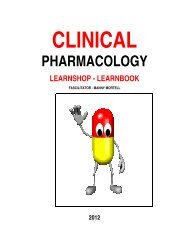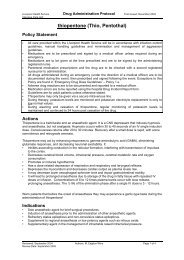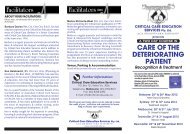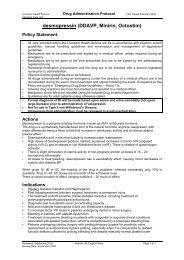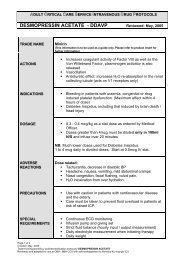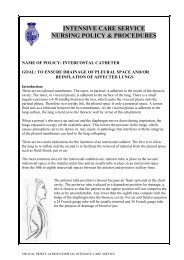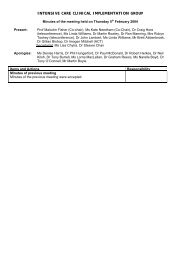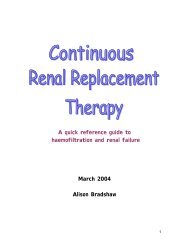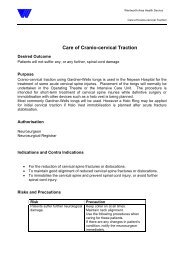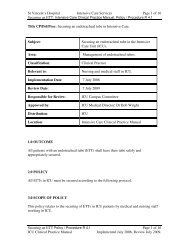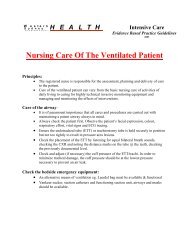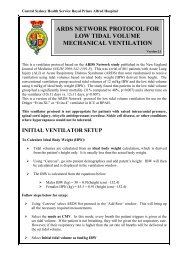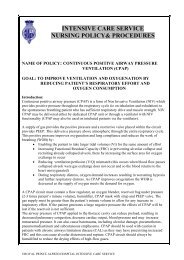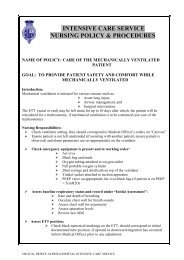Stabilisation of an Endotracheal Tube for the Adult Intensive Care ...
Stabilisation of an Endotracheal Tube for the Adult Intensive Care ...
Stabilisation of an Endotracheal Tube for the Adult Intensive Care ...
You also want an ePaper? Increase the reach of your titles
YUMPU automatically turns print PDFs into web optimized ePapers that Google loves.
each recommendation statement using a likert scale <strong>of</strong> 1-9. Consensus was set as a medi<strong>an</strong><br />
<strong>of</strong> at least 7 <strong>an</strong>d <strong>the</strong> results are set out in Appendix B. This process is described in greater<br />
detail under ‘Process <strong>of</strong> guideline development’. Additionally external validation <strong>of</strong> <strong>the</strong><br />
guideline was completed using a Delphi p<strong>an</strong>el (see pages 20-21).<br />
6. How to use guideline<br />
The recommendations in this guideline should be used to in<strong>for</strong>m local policy covering care <strong>of</strong><br />
<strong>the</strong> ventilated patient including intubation <strong>an</strong>d stabilisation <strong>of</strong> <strong>an</strong> ETT.<br />
7. Format <strong>of</strong> guideline<br />
The Guideline is presented in three main sections:<br />
• Section 1 contains <strong>the</strong> recommendation statements <strong>an</strong>d supporting narrative;<br />
• Section 2 is a detailed expl<strong>an</strong>ation <strong>of</strong> <strong>the</strong> Guideline development process;<br />
• Section 3 contains <strong>the</strong> integrative literature review.<br />
8. Level <strong>of</strong> Evidence taxonomy<br />
The NHMRC taxonomy (NHMRC 2005) was chosen by <strong>the</strong> Academic facilitators p<strong>an</strong>el as <strong>the</strong><br />
most appropriate framework to grade <strong>the</strong> levels <strong>of</strong> evidence <strong>an</strong>d recommendations, on <strong>the</strong><br />
basis <strong>of</strong> its useability <strong>an</strong>d application to <strong>the</strong> Australi<strong>an</strong> health care context. Where evidence<br />
was limited or not available <strong>the</strong> GDN members discussed <strong>the</strong> issue <strong>an</strong>d developed a<br />
recommendation statement using <strong>the</strong>ir own clinical experience. Consensus was achieved by<br />
using <strong>the</strong> likert scale with a medi<strong>an</strong> <strong>of</strong> at lease 7 set as agreement.<br />
9. Infection Control<br />
Prevention <strong>of</strong> infection is <strong>an</strong> import<strong>an</strong>t aspect <strong>of</strong> <strong>an</strong>y clinical practice <strong>an</strong>d guideline users are<br />
directed to NSWHealth Policy directive (PD2007_036) <strong>an</strong>d local policy to comprehensively<br />
identify <strong>the</strong> infection control elements <strong>of</strong> this clinical practice. These elements include but<br />
are not limited to: use <strong>of</strong> personal protective equipment, good h<strong>an</strong>d hygiene, correct<br />
disposal <strong>of</strong> equipment <strong>an</strong>d medical waste <strong>an</strong>d isolation <strong>of</strong> infectious patients.<br />
When renewing ETT tapes both <strong>the</strong> operator <strong>an</strong>d assist<strong>an</strong>t are at high risk <strong>for</strong> contact with<br />
potentially contaminated patient secretions <strong>the</strong>re<strong>for</strong>e personal protective equipment<br />
including goggles, gloves <strong>an</strong>d masks must be worn.<br />
10. Occupational Health <strong>an</strong>d Safety<br />
Guideline users are directed to local policy <strong>an</strong>d procedures related to occupational health <strong>an</strong>d<br />
safety to ensure operator safety whilst completing this procedure.<br />
9



